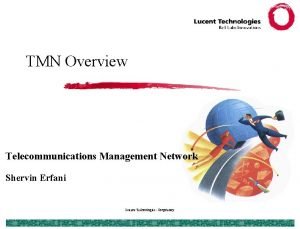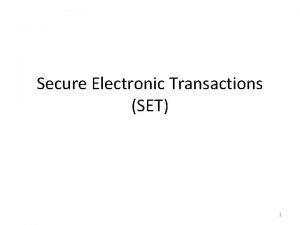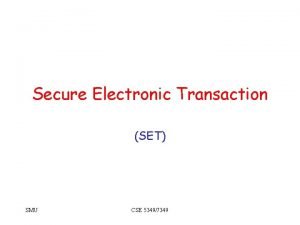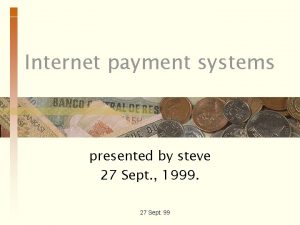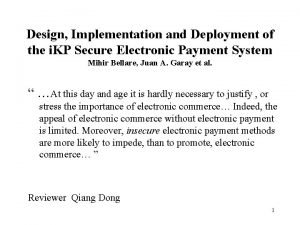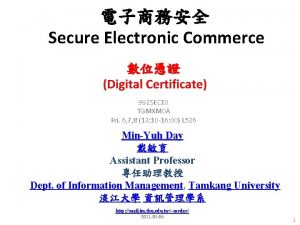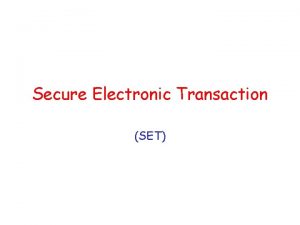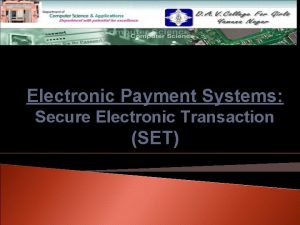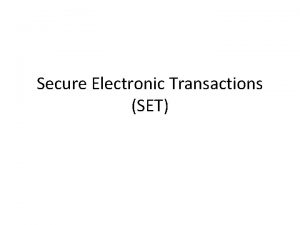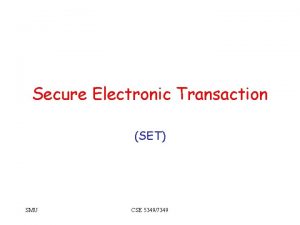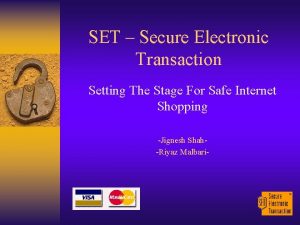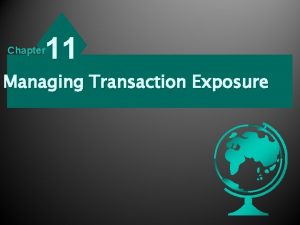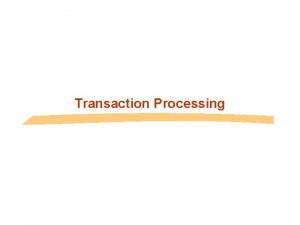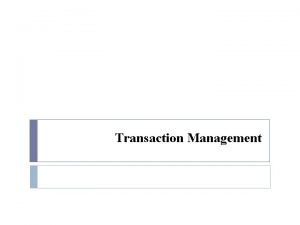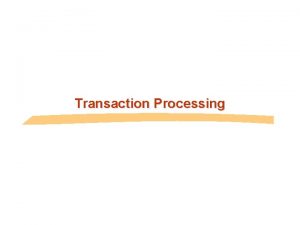Secure Electronic Transaction SET Shervin Erfani Electrical and
















- Slides: 16

Secure Electronic Transaction (SET) Shervin Erfani Electrical and Computer Engineering Department University of Windsor December 2003 Reference: Chapter 7 of the Text, pp. 234 -247 December 2, 2003 ECE Dept. – University of Windsor 1

Overview of SET • • What is SET Protocol? What is the Goal of SET? How does it work? What does SET provide? December 2, 2003 ECE Dept. – University of Windsor 2

SET Protocol • The current version, SETv 1, is a set of security protocol and formats to establish credit card transactions on the Internet. • Provides a secure communication channel among all parties involved in an E-commerce transaction • Provides trust by the use of X. 509 v 3 digital certificates • Ensures privacy December 2, 2003 ECE Dept. – University of Windsor 3

Secure Electronic Commerce Component December 2, 2003 ECE Dept. – University of Windsor 4

Participants in the SET System • CARDHOLDER – Consumers and corporate purchasers using the Internet to Merchants • MERCHANT – An organization that offers goods or services over the Internet • ISSUER – A financial institution or bank providing the cardholder with the payment card • ACQUIRER – A financial institution that processes payment card authorizations and payments on behalf of the merchant • PAYMENT GATEWAT – A security interface function to process merchant payment messages for the Acquirer • CERTIFICATION AUTHORITY (CA) – A trusted entity 3 rd party issuing X. 509 v 3 public-key certificates for cardholder, merchants, and payment gateways. December 2, 2003 ECE Dept. – University of Windsor 5

SET Encryption Overview December 2, 2003 ECE Dept. – University of Windsor 6

SET Encryption Process Sender’s Functions – Step 1 – Alice generate MD of the plaintext, using a one-way hash Data Integrity – Step 2 – Alice encrypts the generated MD using her private key – Digital Signature – Step 3 – Alice encrypts the plaintext, MD, and her certificate, using a generated session key (i. e. , the hypertext) Privacy – Step 4 – Alice encrypts her generated symmetric session key with Bob’s public key ( i. e. , a Digital Envelope) Confidentiality – Step 5 – Alice sends the hypertext along with the Digital Envelope to Bob December 2, 2003 ECE Dept. – University of Windsor 7

SET Encryption Process (Cont. ) Receiver’s Functions – Step 6 – Receiving Alice’s message, Bob decrypts the Digital Envelope, using his private key to retrieve the session key Decrypt Digital Envelope – Step 7 – Bob decrypts the decrypted message using the session key Decryption – Step 8 – Bob decrypts the digital signature, using Alice’s public key Recover the MD – Step 9 – Bob runs the plaintext through the same one-way hash to produce a new MD for the received plaintext Integrity Check – Step 10 – Bob compares the generated MD with the received MD for Integrity Check; otherwise, he discards the message and notifies Alice ACk or NAK December 2, 2003 ECE Dept. – University of Windsor 8

Certificate Issuance • SET certificates are verified through a hierarchy of trust. • The public signature key of the root is known to all SET participants. • The root key will be distributed in a self-signed certificate. • A party can confirm its valid root key by sending an initiate request to the CA that has the root key. • A replacement key for the root key is stored securely until it is needed. December 2, 2003 ECE Dept. – University of Windsor 9

SET Payment Processing SET defines a variety of transaction protocols to securely conduct E-Commerce: v. Cardholder Registration v. Merchant Registration v. Purchase Request v. Payment Authorization v. Payment Capture December 2, 2003 ECE Dept. – University of Windsor 10

Cardholder Registration December 2, 2003 ECE Dept. – University of Windsor 11

Merchant Registration December 2, 2003 ECE Dept. – University of Windsor 12

Purchase Request December 2, 2003 ECE Dept. – University of Windsor 13

Payment Authorization December 2, 2003 ECE Dept. – University of Windsor 14

Payment Capture December 2, 2003 ECE Dept. – University of Windsor 15

What Does SET Provide? • Confidentiality of Information: Conventional encryption such as DES is used for passing Cardholder account and payment information. • Integrity of Data: RSA digital signature using SHA-1 hash codes are used. • Cardholder Account Authentication: using X. 509 v 3 digital certificates with RSA signatures. • Merchant Authentication: SET uses X. 509 v 3 digital certificates with RSA signatures December 2, 2003 ECE Dept. – University of Windsor 16
 Telecommunication management network
Telecommunication management network Features of secure electronic transaction
Features of secure electronic transaction Secure electronic transaction advantages disadvantages
Secure electronic transaction advantages disadvantages Secure electronic transaction advantages disadvantages
Secure electronic transaction advantages disadvantages Benefits of electronic payment system
Benefits of electronic payment system Eila erfani
Eila erfani I kp
I kp Total set awareness set consideration set
Total set awareness set consideration set Training set validation set test set
Training set validation set test set Tgmxm
Tgmxm Electronic field production
Electronic field production Shervin taghavi
Shervin taghavi Shervin ghasemlou
Shervin ghasemlou Shervin taghavi
Shervin taghavi An electronic is the electronic exchange of money or scrip
An electronic is the electronic exchange of money or scrip What is the overlap of data set 1 and data set 2?
What is the overlap of data set 1 and data set 2? Bounded set vs centered set
Bounded set vs centered set
